Simplify your marketing automation strategy. Use AI to personalize campaigns, optimize workflows, and turn data into actionable insights effortlessly.
Read More »

If you're like many business owners, growing your business is your main concern but you're likely overwhelmed by repetitive tasks, as well as the rising costs associated with hiring and maintaining your team. You probably also have concerns about whether automation requires expensive specialists or technical know-how, and will there be any on-going monthly costs and maintenance?
In this guide, we’ll explore everything you need to know about Business Process Automation (BPA): what it is, why it matters, and how your business and workflows can leverage it to stay competitive in today’s fast-paced AI automated landscape.
Business Process Automation is the use of software and systems to execute recurring tasks or processes in a business where manual effort can be replaced. It’s about streamlining workflows, reducing human error, cutting costs, and enhancing business workflow automation.
Think of BPA as your tireless operations manager, handling processes like lead generation, inventory management, contract approvals, or purchase order processing—all without missing a beat.
Automating your business processes can not only boost efficiency and reduce costs but also ensure consistency and deliver reliable, repeatable results. Here are five main areas where BPA can help your business and workflows thrive:
When repetitive tasks like invoice generation or customer onboarding are automated, you save hours of manual effort by automating business processes. Tools like Zapier or Make (formerly Integromat) streamline multi-step processes across platforms, and connect with all the apps you and your team already use.
By eliminating tedious tasks, your team can focus on creative, high-value work. Imagine an HR manager spending time on employee engagement strategies rather than manual payroll calculations, or a sales person closing more deals in-person by having cold email outreach fully automated.
Automating your business workflows isn't as expensive as you think. Manual tasks are resource-intensive. Automating workflows reduces the cost per task, and it's completely scalable. For instance, automating email marketing campaigns with platforms like Mailchimp or Active Campaign can lead to better ROI.
With BPA, your business processes consistently deliver high-quality results. Whether it's generating accurate financial reports on time, ensuring compliance procedures are met without stress, or maintaining uniform customer communication, BPA ensures nothing falls through the cracks. For example, automating customer feedback collection gathers data consistently, enabling better analysis and decision-making.
Implement AI chatbots like Zendesk or Zobot to handle frequently asked questions, reducing customer service workload. The majority of those initial customer service interactions (from your website, email or app) can be handled by a chatbot, and only need a human to step in for more complex requests and scenarios.
Automate invoice generation and payment reminders with tools like QuickBooks or Xero.
Use workflow automation software like BambooHR earlier in your processes to handle new employee documentation and training schedules effectively. You're also able to have other tasks such as setting up employee email accounts, resource folder, app access etc, with the help of of automation tools like Make.com
Automate inventory tracking to reduce stock discrepancies and streamline restocking. This helps prevent overstock or stockouts and saves hours of manual checks. ChatGPT can analyse your sales data to give you strategic advice on sales trends.
Implement automation to handle incoming sales orders, from initial capture to order fulfillment, ensuring fast and accurate processing with minimal human intervention.
Simplify the approval process by automating contract creation, routing, and tracking. This reduces bottlenecks and makes it easier to handle contracts at scale.

List all recurring processes suited for automation in your business. Involve your team with a simple group chat/meeting or survey to understand what's taking up most of their time, as they can provide valuable insights. This might include tasks like data entry, scheduling, or document management.
Evaluate platforms based on your needs. See the automation platforms below. Some of my top picks include.
Start small by automating a single process. Focus on quick wins—tasks that are easy to automate and give noticeable benefits. Common examples include automating email notifications, data entry, appointment scheduling, client communications, or meeting-related tasks like setting reminders and follow-ups.

Business automation tools can enhance personal and business efficiency, especially when combined with AI business process automation. To make the best choice for your business, it's crucial to understand the different automation platforms available, how they align with your specific needs, and what benefits they offer.
Each platform has unique features, and by exploring them, you can determine which one is most effective for your workflow and goals.
| Level | Platform | Best For | Pricing |
|---|---|---|---|
| Entry | Zapier | Connecting apps seamlessly | From $19.99/month |
| Entry | Trello | Task management and simple automation | Free | $5 user/month |
| Entry | Airtable | Flexible database with automation | From $12/user/month |
| Intermediate | Make.com | Advanced workflows and AI integration | From $9/month |
| Intermediate | ClickUp | Project management + automation | From $5/user/month |
| Intermediate | Notion AI | Note-taking with AI and workflow tools | From $8/user/month |
| Advanced | UiPath | Advanced AI-driven automation | Custom pricing |
| Advanced | Automation Anywhere | End-to-end process automation | Custom pricing |
| Advanced | Blue Prism | Robotic Process Automation (RPA) | Custom pricing |
Cost is probably a concern. So how do you measure success by automating. Automation often delivers high ROI by reducing labor costs and increasing efficiency. For instance, let's break down the impact of automating a common process like invoicing. Suppose your business processes 100 invoices per month, each taking an average of 30 minutes when done manually - and including any client follow ups etc. That's 50 hours spent monthly on invoicing. By automating this process, you could reduce that time by 80%, freeing up 40 hours per month. This translates to significant cost savings.
Absolutely! Automation is perfect for small businesses because owners often have a deep understanding of their processes, as they've likely been managing them personally. With fewer team members and less business complexity, small businesses can be more agile, implementing automation quickly without the need for extensive training.
No, BPA involves automating processes, while AI focuses on decision-making and learning. However, AI can enhance BPA, such as using predictive analytics for customer behavior. For example, using a tool like Make.com, you can set up automation that not only processes customer support tickets but also uses AI to understand customer sentiment. This allows the system to intelligently prioritize urgent requests and even offer personalized responses, effectively handling many queries without needing human intervention. AI automation is similar to BPA but is more tightly integrated with AI models and processes.
Business Process Automation isn’t just a trend—it’s a necessity for businesses aiming to thrive in a competitive landscape. Whether you’re looking to save time, reduce costs, or streamline workflows, BPA offers a tailored solution for your needs.
Start small by making automation a goal for the quarter. Identify quick wins, plan with your team, and implement them step-by-step. Once in place, monitor and refine the processes to maximize their impact.
If you need assistance navigating your automation journey, reach out to me—I specialize in AI-driven business automation and can help make the process seamless and effective.
Start small, scale smart, and transform your business today!

With 20+ years in eCommerce and a proven history of scaling a 7-figure business, I know how to transform challenges into opportunities for growth. As the former Head of E-commerce for a European food tech company, I managed 14 e-shops across Europe and South Africa. Now, I specialise in helping professionals like you unlock the potential of AI automation for your business.
Over 1,800 students have already enrolled in my online courses to master these skills. Whether you’re looking for hands-on AI automation services or want to upskill with my courses, I’m here to help. Connect with me on LinkedIn to discuss your needs or join my programs to start building smarter, more scalable systems today!
Simplify your marketing automation strategy. Use AI to personalize campaigns, optimize workflows, and turn data into actionable insights effortlessly.
Discover how AI content automation transforms workflows with tools for automatic content creation, saving time while enhancing creativity, efficiency, and scalability.
Discover how TikTok automation using AI can streamline your content creation process. Learn tools, tips, and strategies to save time, boost engagement, and grow your TikTok presence effortlessly.